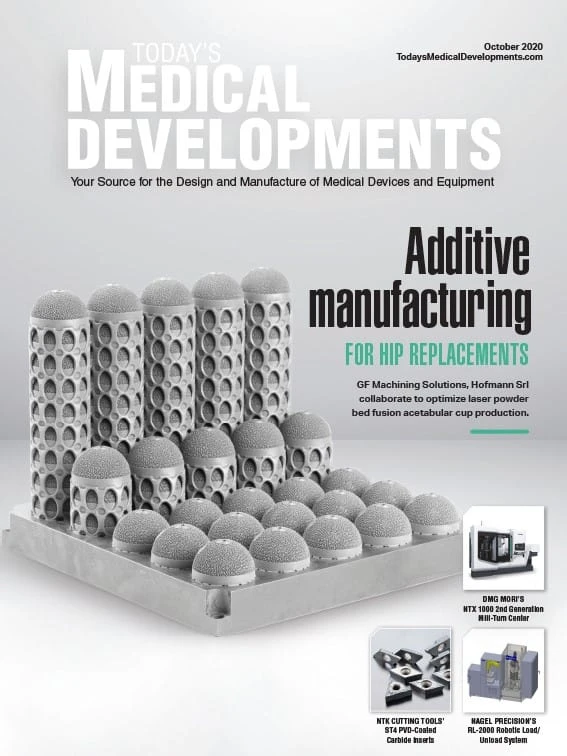
A5-in-1 portable device, Ventec Life Systems’ VOCSN ventilator can perform five therapies for patients who have lost lung function – ventilator, portable oxygen concentrator, cough stimulator, suction, and nebulizer. As a portable critical care ventilator, VOCSN is ideal for COVID-19 treatment, and as a result the company received a large federal contract in April 2020 to make 30,000 units with manufacturing partner General Motors (see sidebar, page 25).
The multi-function device eliminates constantly disconnecting circuits to switch between devices to breathe, manage airway clearance, and medication delivery. That reduces infection risk and streamlines care with a portable device usable in the comfort of one’s home or in a healthcare facility.
Controlled with an intuitive touchscreen, the device delivers treatments in seconds rather than minutes. And because Ventec is constantly innovating and updating the user interface, the company relies heavily on Crank Software’s Storyboard platform to tweak graphics and optimize animations. Storyboard provides an intuitive graphical user interface (GUI) support for the ventilator, which also allows Ventec to iterate new designs to work through development and maintain easy usability. The platform provides a modern user interface and allows Ventec to focus on speed when it matters most.

Rapid response design features
During the initial COVID-19 outbreak, Ventec was in constant communication with governors and state health officials discussing how it was affecting patients and the critical, immediate need for ventilators. Rather than develop something completely new, the company wanted to take its already proven design and focus on scale to fulfill capacity.
“VOCSN was already in use, and we were already growing our manufacturing capacity month to month, but we knew that we were going to have to significantly increase our capacity to meet the heightened need,” says Chris Brooks, Ventec’s chief strategy officer. “And when you think about responding to a pandemic, where you potentially have non-clinical personnel, as well as doctors and respiratory therapists who are using these devices, you want something that’s very easy to use. All of the original design features that were built into VOCSN came in really handy to the pandemic response.”
They knew they could rely on the Storyboard platform to make design updates and add functionality to the touchscreen application within 30 days.
The VOCSN software now includes preset ventilation functions to better serve the needs of frontline medical professionals fighting COVID-19. Making the necessary changes, Ventec was able to rapidly create, design, test, and validate the new GUI to quickly test, receive approval, and deploy new software.
“For safe operation of the device, it was critical that the touchscreen was intuitive, easy to use, and that it provided the necessary immediate feedback to the user upon touch,” says Brian Edmond, president of crank Software. “Our Storyboard platform enabled them to easily turn all those requirements into a GUI application within their necessary timeframe.”
During the development phase, the software allowed them to create their GUI screens and ensure their design intention was realized. Storyboard’s flexibility allowed Ventec to easily import design files, edit and animate, and quickly begin app development. Instead of facing time delays that can occur when working with developers and having engineers re-code progress on the development side, Ventec’s designers could focus on the graphics and maintenance of the user experience they needed, while the developers worked on the system integration and code.
The platform’s built-in simulator allowed the team to quickly see and interact with the touchscreen application on their desktop, without requiring hardware or the end target device. They were able to prototype screens, test and refine the look and feel on desktops, enabling rapid design iteration and tweaking to improve overall performance.
“They could leverage our system where we’ve already taken care of how it displays to the screen, made sure it’s reactive to the user and displays the content visually,” Edmond adds. “And they could focus on the design and the usability of it and not have to worry about figuring out how to develop, which allows them to shorten their development cycles and focus on other areas that sometimes you would get bogged down.”
Crank’s Storyboard software was also used to build the application that runs the user interface offline. Designed around usability, look and feel, and maximum performance, users receive the necessary feedback while in use.
“The ability to record and know when the therapy was administered, you know what the vacuum pressures look like during that therapy,” Brooks adds. “And you can also now track all five therapies and how they were delivered to better understand what care looks like for the patient, but also be able to better customize their care plans.”



Completing orders, furthering health safety
While the federal order for 30,000 critical care ventilators was officially completed at the end of August, Ventec continues to manufacture at scale at the Bothell, Washington, and the Kokomo, Indiana, facilities in response to ongoing demand. Brooks goes on to explain how they continue to see requests for ventilators, particularly as flu season begins. Until there is a vaccine, a cure, or other therapeutics for COVID, he expects ventilators to remain part of the public health safety net, ensuring that frontline medical professionals have the tools that they need to take care of patients.
“VOCSN truly was built for exactly this situation. We’re very proud of the team and how they’ve been able to step up and literally work around the clock since February to provide access to VOCSN,” Brooks concludes. “And certainly, partners like Crank have enabled our team to iterate quickly and provide something that can be customized to the task at hand, which in this case has been responding to COVID.”
Crank Software
https://www.cranksoftware.com
Ventec Life Systems
https://www.venteclife.com
About the author: Michelle Jacobson is the assistant editor of TMD. She can be reached at mjacobson@gie.net or 216.393.0323

Explore the October 2020 Issue
Check out more from this issue and find your next story to read.
Latest from Today's Medical Developments
- Supply Chain Power – A strategic program for executives
- Sunnen Products' PGE-6000 gage
- April Manufacturing Lunch + Learn with Iscar
- April Manufacturing Lunch + Learn with Insaco
- Laser cold marking for plastic medical device manufacturing
- Paperless Parts’ BOM Builder
- #58 - Manufacturing Matters - 2024 Metrology's Latest Advancements with Starrett
- Strategies to improve milling and turning for medical components





